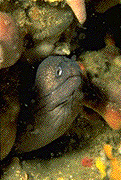Moray eel: Difference between revisions
GrahamBould (talk | contribs) Remove Enchelycore species as on genus page |
GrahamBould (talk | contribs) Remove Anarchias species as on genus page |
||
| Line 48: | Line 48: | ||
* Subfamily [[Uropterygiinae]] |
* Subfamily [[Uropterygiinae]] |
||
** ''[[Anarchias]]'' |
** ''[[Anarchias]]'' |
||
*** [[Allardice's moray]], ''[[Anarchias allardicei]]'' |
|||
*** [[Canton Island moray]], ''[[Anarchias cantonensis]]'' |
|||
*** ''[[Anarchias euryurus]]'' |
|||
*** [[Minute moray]], ''[[Anarchias galapagensis]]'' |
|||
** ''[[Channomuraena]]'' |
|||
*** [[Broadbanded moray]], ''[[Channomuraena vittata]]'' |
|||
** ''[[Scuticaria]]'' |
** ''[[Scuticaria]]'' |
||
*** [[Shorttailed snake moray]], ''[[Scuticaria okinawae]]'' |
*** [[Shorttailed snake moray]], ''[[Scuticaria okinawae]]'' |
||
Revision as of 17:01, 14 August 2006
| Moray eel | |
|---|---|

| |
| Reticulated moray, Gymnothorax polygonius | |
| Scientific classification | |
| Kingdom: | |
| Phylum: | |
| Class: | |
| Order: | |
| Family: | Muraenidae
|
| Genera | |
|
See text. | |
Moray eels are large cosmopolitan eels of the family Muraenidae. There are approximately 200 species in 15 genera, the largest being the slender giant moray, Strophidon sathete, at up to 4 m (13 feet) in length. Most morays measure in at 1.5 m (5 feet) in length.
Moray eels frequent tropical and subtropical coral reefs to depths of 200 m, where they spend most of their time crammed inside crevices and alcoves. They secrete a protective mucus over their scaleless skin which contains a toxin in some species. Their small circular gills, located on the flanks far posterior to the mouth, require the moray eel to maintain a gape in order to facilitate respiration.
The dorsal fin extends from just behind the head, along the back and joins seamlessly with the caudal and anal fin. Most species lack pectoral and pelvic fins, adding to their snake-like appearance. Their eyes are rather small; morays rely on their highly developed sense of smell, lying in wait to ambush their prey.
Their bodies are patterned cryptically, the camouflage also being present inside the mouth. Their wide jaws are armed with sizable sharp teeth efficient at tearing flesh, making moray eels a subject best enjoyed from afar.
Morays are carnivorous and feed primarily on other fish, cephalopods and crustaceans. Groupers and other moray eels are among their few predators. There is a commercial fishery for several species, but some have been known to cause ciguatera fish poisoning.
Species
The following is an incomplete breakdown of the family. Please add to it as required.
- Subfamily Muraeninae
- Subfamily Uropterygiinae
External link
- Froese, Rainer, and Daniel Pauly, eds. (2006). "Muraenidae" in FishBase. January 2006 version.
- http://www.itis.usda.gov ITIS Taxonomic Serial No.: 161160



